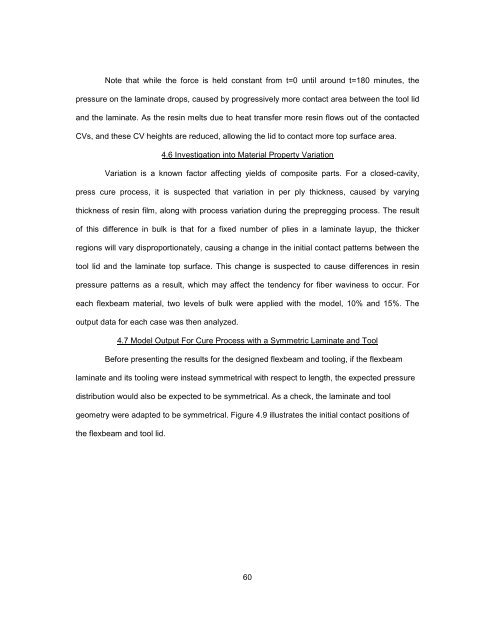TOOLED THICK COMPOSITES by ARVEN H. SAUNDERS III ...
TOOLED THICK COMPOSITES by ARVEN H. SAUNDERS III ...
TOOLED THICK COMPOSITES by ARVEN H. SAUNDERS III ...
You also want an ePaper? Increase the reach of your titles
YUMPU automatically turns print PDFs into web optimized ePapers that Google loves.
Note that while the force is held constant from t=0 until around t=180 minutes, the<br />
pressure on the laminate drops, caused <strong>by</strong> progressively more contact area between the tool lid<br />
and the laminate. As the resin melts due to heat transfer more resin flows out of the contacted<br />
CVs, and these CV heights are reduced, allowing the lid to contact more top surface area.<br />
4.6 Investigation into Material Property Variation<br />
Variation is a known factor affecting yields of composite parts. For a closed-cavity,<br />
press cure process, it is suspected that variation in per ply thickness, caused <strong>by</strong> varying<br />
thickness of resin film, along with process variation during the prepregging process. The result<br />
of this difference in bulk is that for a fixed number of plies in a laminate layup, the thicker<br />
regions will vary disproportionately, causing a change in the initial contact patterns between the<br />
tool lid and the laminate top surface. This change is suspected to cause differences in resin<br />
pressure patterns as a result, which may affect the tendency for fiber waviness to occur. For<br />
each flexbeam material, two levels of bulk were applied with the model, 10% and 15%. The<br />
output data for each case was then analyzed.<br />
4.7 Model Output For Cure Process with a Symmetric Laminate and Tool<br />
Before presenting the results for the designed flexbeam and tooling, if the flexbeam<br />
laminate and its tooling were instead symmetrical with respect to length, the expected pressure<br />
distribution would also be expected to be symmetrical. As a check, the laminate and tool<br />
geometry were adapted to be symmetrical. Figure 4.9 illustrates the initial contact positions of<br />
the flexbeam and tool lid.<br />
60
















